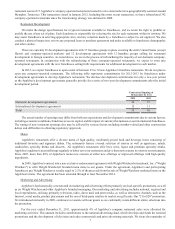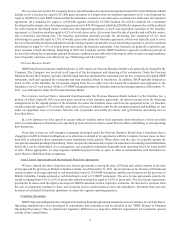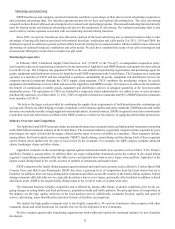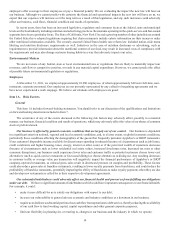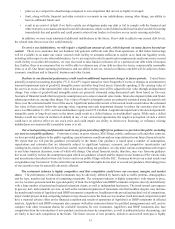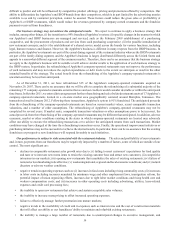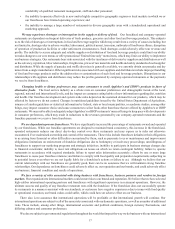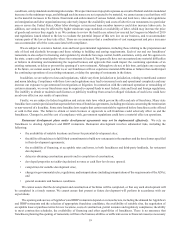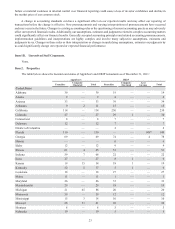IHOP 2011 Annual Report Download - page 34
Download and view the complete annual report
Please find page 34 of the 2011 IHOP annual report below. You can navigate through the pages in the report by either clicking on the pages listed below, or by using the keyword search tool below to find specific information within the annual report.16
difficult to predict and will be influenced by competitive product offerings, pricing and promotions offered by competitors. Our
ability to differentiate the Applebee's and IHOP brands from their competitors, which is in part limited by the advertising monies
available to us and by consumer perception, cannot be assured. These factors could reduce the gross sales or profitability at
Applebee's or IHOP restaurants, which would reduce the revenues generated by company-owned restaurants and the franchise
payments received from franchisees.
Our business strategy may not achieve the anticipated results. We expect to continue to apply a business strategy that
includes, among other things, (i) the transition to a 99% franchised Applebee's system; (ii) specific changes in the manner in which
our Applebee's and IHOP businesses are managed and serviced, such as the February 2009 establishment of a purchasing
cooperative, and the procurement of products and services from such purchasing cooperative; (iii) the possible introduction of
new restaurant concepts; and (iv) the establishment of a shared service model across the brands for various functions, including
legal, human resources and finance. However, the Applebee's business is different in many respects from the IHOP business. In
particular, the Applebee's restaurants are part of the casual dining segment of the restaurant industry whereas the IHOP restaurants
are part of the family dining segment, and the Applebee's business is larger, distributed differently across the United States and
appeals to a somewhat different segment of the consumer market. Therefore, there can be no assurance that the business strategy
we apply to the Applebee's business will be suitable or will achieve similar results to the application of such business strategy to
the IHOP system. In particular, the refranchising of Applebee's company-operated restaurants may not improve the performance
of such restaurants and may not reduce the capital expenditures or debt levels to the extent we anticipate or result in the other
intended benefits of the strategy. The actual benefit from the refranchising of the Applebee's company-operated restaurants is
uncertain and may be less than anticipated.
As of December 31, 2011, we have refranchised 325 of the Applebee's company-operated restaurants acquired on
November 29, 2007. There can be no assurance that we will be able to complete the refranchising of a substantial majority of the
remaining 177 company-operated restaurants on terms that we and our creditors would consider desirable or within the anticipated
time frame. In October 2011, we entered into an agreement for the refranchising and sale of related restaurant assets of 17 Applebee’s
company-operated restaurants located in a six-state market area geographically centered around Memphis, Tennessee. The
transaction closed in January 2012. Following these transactions, Applebee's system is 91% franchised. The anticipated proceeds
from the refranchising of the company-operated restaurants are based on current market values, recent comparable transaction
valuations, and a number of other assumptions. The refranchising of Applebee's company-operated restaurants may not be
completed for several years. If market rents, comparable transaction valuations or other assumptions prove to be incorrect, the
actual proceeds from the refranchising of the company-operated restaurants may be different than anticipated. In addition, adverse
economic, market or other conditions existing in the states in which company-operated restaurants are located may adversely
affect our ability to execute the refranchising transactions or to achieve the anticipated returns from such transactions. Market
conditions may have changed at the time the refranchising transactions occur. Finally, the operational improvement initiatives or
purchasing initiatives may not be successful or achieve the desired results. In particular, there can be no assurance that the existing
franchisees or prospective new franchisees will respond favorably to such initiatives.
Our performance is subject to risks associated with the restaurant industry. The sales and profitability of our restaurants
and, in turn, payments from our franchisees may be negatively impacted by a number of factors, some of which are outside of our
control. The most significant are:
• declines in comparable restaurant sales growth rates due to: (i) failing to meet customers' expectations for food quality
and taste or to innovate new menu items to retain the existing customer base and attract new customers; (ii) competitive
intrusions in our markets; (iii) opening new restaurants that cannibalize the sales of existing restaurants; (iv) failure of
national or local marketing to be effective; (v) weakening national, regional and local economic conditions; and (vi) natural
disasters or adverse weather conditions.
• negative trends in operating expenses such as: (i) increases in food costs including rising commodity costs; (ii) increases
in labor costs including increases mandated by minimum wage and other employment laws, immigration reform, the
potential impact of union organizing efforts, increases due to tight labor market conditions and rising health care and
workers compensation costs; and (iii) increases in other operating costs including advertising, utilities, lease-related
expenses and credit card processing fees;
• the inability to open new restaurants that achieve and sustain acceptable sales volumes;
• the inability to increase menu pricing to offset increased operating expenses;
• failure to effectively manage further penetration into mature markets;
• negative trends in the availability of credit and in expenses such as interest rates and the cost of construction materials
that will affect our ability or our franchisees' ability to maintain and refurbish existing restaurants;
• the inability to manage a large number of restaurants due to unanticipated changes in executive management, and



